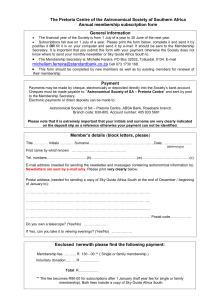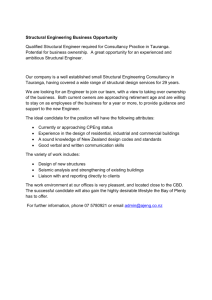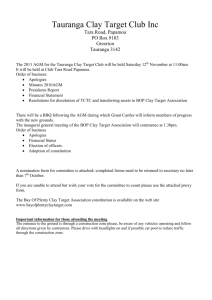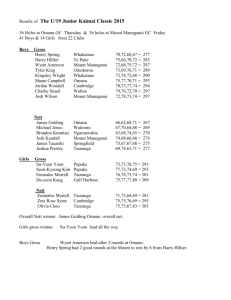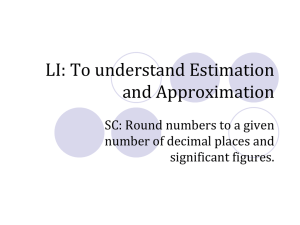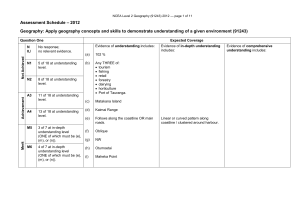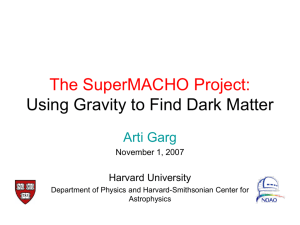13 July/August 2006 - Tauranga Astronomical Society
advertisement
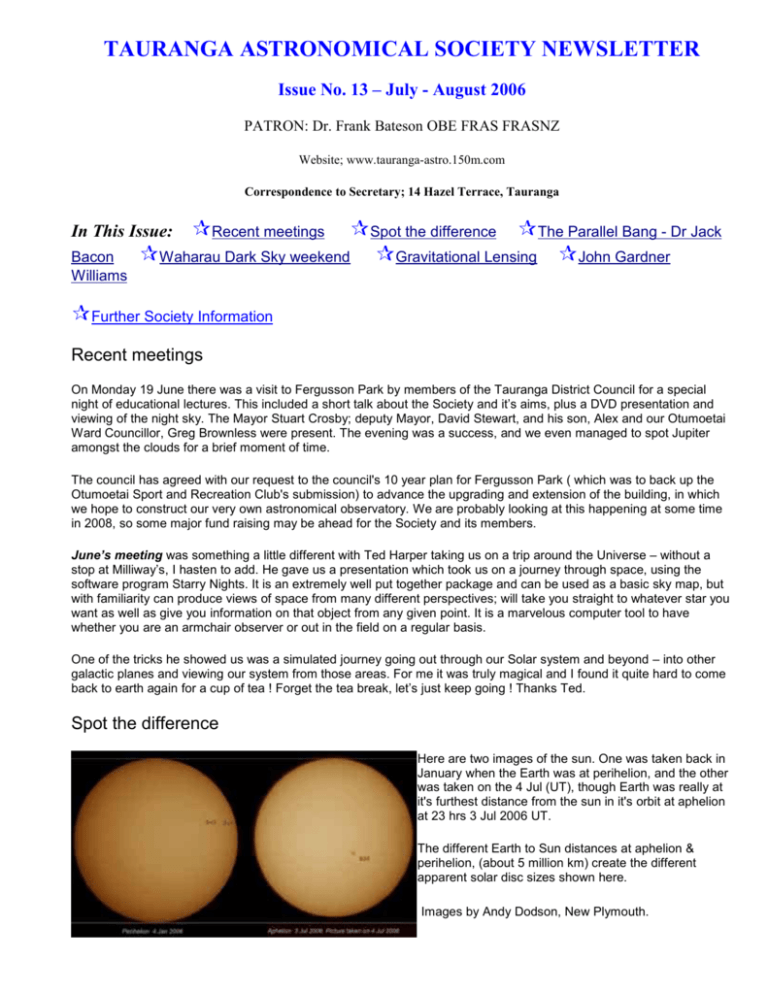
TAURANGA ASTRONOMICAL SOCIETY NEWSLETTER Issue No. 13 – July - August 2006 PATRON: Dr. Frank Bateson OBE FRAS FRASNZ Website; www.tauranga-astro.150m.com Correspondence to Secretary; 14 Hazel Terrace, Tauranga Spot the difference The Parallel Bang - Dr Jack Waharau Dark Sky weekend Gravitational Lensing John Gardner In This Issue: Bacon Williams Recent meetings Further Society Information Recent meetings On Monday 19 June there was a visit to Fergusson Park by members of the Tauranga District Council for a special night of educational lectures. This included a short talk about the Society and it’s aims, plus a DVD presentation and viewing of the night sky. The Mayor Stuart Crosby; deputy Mayor, David Stewart, and his son, Alex and our Otumoetai Ward Councillor, Greg Brownless were present. The evening was a success, and we even managed to spot Jupiter amongst the clouds for a brief moment of time. The council has agreed with our request to the council's 10 year plan for Fergusson Park ( which was to back up the Otumoetai Sport and Recreation Club's submission) to advance the upgrading and extension of the building, in which we hope to construct our very own astronomical observatory. We are probably looking at this happening at some time in 2008, so some major fund raising may be ahead for the Society and its members. June’s meeting was something a little different with Ted Harper taking us on a trip around the Universe – without a stop at Milliway’s, I hasten to add. He gave us a presentation which took us on a journey through space, using the software program Starry Nights. It is an extremely well put together package and can be used as a basic sky map, but with familiarity can produce views of space from many different perspectives; will take you straight to whatever star you want as well as give you information on that object from any given point. It is a marvelous computer tool to have whether you are an armchair observer or out in the field on a regular basis. One of the tricks he showed us was a simulated journey going out through our Solar system and beyond – into other galactic planes and viewing our system from those areas. For me it was truly magical and I found it quite hard to come back to earth again for a cup of tea ! Forget the tea break, let’s just keep going ! Thanks Ted. Spot the difference Here are two images of the sun. One was taken back in January when the Earth was at perihelion, and the other was taken on the 4 Jul (UT), though Earth was really at it's furthest distance from the sun in it's orbit at aphelion at 23 hrs 3 Jul 2006 UT. The different Earth to Sun distances at aphelion & perihelion, (about 5 million km) create the different apparent solar disc sizes shown here. Images by Andy Dodson, New Plymouth. The Parallel Bang - Dr Jack Bacon Rocket scientist, author, futurist, veteran of television and radio, and worldwide speaker Dr. Jack Bacon was in New Zealand on a country-wide tour during June. We were able to attend one of his talks at the Rotorua District Council Chamber. Dr.Bacon has first-hand experiences in the world's space programs from Japan, throughout the US and Europe, and in Russia within the International Space Station effort, and the focus of his lecture addressed the pace of technology, its future impact on society, and the value of an education in today's world. He has a very charismatic nature and personally introduced himself to each on of us at the lecture – a great start to the evening. Dr. Bacon says; Humans have been doubling what we know and what we can do every 30 years since the Renaissance, and after each lifetime of such change, it is always easy for an older person to believe that life is now "too fast". If you step back and take the broader view, you can soon see that in THIS generation, they might be right. The pace is showing lots of signs of actually picking up in many facets of society, giving new reasons to share in our elders' bewilderment. Economic cycles are ten times shorter than a century ago, manufacturing efficiencies are taking off at greater rates, global communication and digital storage are essentially free, and basic science and technology are making huge leaps that defy the 30 year doubling rule. If the universe started with a Big Bang, it appears that human understanding of that universe now going through an explosive new creation of its own. A shift in human society is going on today that will totally eclipse the growth increases of the Renaissance, and history will look back at this decade with reverence and awe. Dr. Bacon explored some of the data that supports this prophecy, and we looked at what may happen to the world as we go through this "Parallel Bang" of understanding. Many thanks to the hard work of Jim Barrowclough and the committee for organizing the trip – we were able to enjoy the luxury of a bus trip, rather than journey in several cars. And the hands on the head? Well it was to give us an idea of how big our brains really are. Waharau Dark Sky weekend (April 2006) With all the inclement weather leading up to the weekend, including flooded roads in the Karangahake Gorge, we nearly decided to call the trip off – but as luck would have it, the skies cleared on the Friday afternoon and we arrived at Waharau on the western side of the Firth of Thames coast just after dark. The Waharau site has about 12 cabins scattered around the amenities building. Each cabin has bunk beds for 8 people. There were also hot showers available and generally the facilities were excellent for a weekend stay. On the Friday night, I was able to set up the Barn Door Tracker (a homemade manual equatorial camera tracking mount) and make one good 5min exposure under a beautiful clear sky. After borrowing some cables, I was able to download the image to a laptop to check it for clarity. It was here that I received much assistance from Dave Moorhouse who showed me how to enhance my photo using both Maxim and Photoshop software. Image shows Scorpius. Antares is the large yellow star in the upper left quadrant. Taken on the Barn Door Tracker with Canon EOS300D 18-55mm lens f5.6 for 5mins and one dark frame subtracted. He also introduced me to the concept of taking "dark frames". These are simply exposures taken with the lens cap on at the same temperature and settings as the actual photos being taken. The dark frames then show the noise that is a product of the camera’s CCD chip. Using the software programs above, this noise can then be subtracted from the original photo (difference blending mode in Photoshop) and does a great job of cleaning up an image. Unfortunately, after much time spent with Dave, the sky had clouded over and no more images were taken that night. Dave had also set up a computer with a sensor to monitor the cloud and temperature conditions from inside the building. The output is shown visually on screen as two scrolling graphs and he demonstrated how it can be used to trigger an alarm to allow a stargazer to sleep until awakened when the sky clears – could be a handy device. Saturday was light rain all day – so nobody was able to do any observing of the sun. We spent the morning with a very pleasant bush walk around area surrounding the camp. This area backs onto the Hunua Ranges although we didn’t venture too far in the conditions. There is also a ropes course next to the camp and it is only a short distance down to the beach. Of course you could also sit around by the kitchen and drink beer if that helped pass the time on a wet day. Later that night, at around 9pm, the rain stopped and the sky finally cleared. We then got clear skies until about 3am. This gave everyone ample opportunity to observe the stars. I was able to see how the Milky Way rotated from East-West to almost a North-South alignment by that time of the morning. Many of us spent a fascinating evening viewing Jupiter, especially as we watched the beginning of a transit of one of Jupiter’s moons. I was also able to get some more exposures made with the tracker and then spend some time viewing through other telescopes. I spent some time marvelling at the intricate tiny threads of stars around Eta Carina and the amount of gas and dust in the Sagittarius part of the Milky Way. Barry Raynel Gravitational Lensing This isn’t as complicated or esoteric as it looks ……the subject of gravitational lensing came up more than once during the presentations at the Royal Astronomical Society of New Zealand’s conference in July . It fascinated me and I thought I would pass on some information in this newsletter. Basically it is the bending of light waves as one object passes in front of another, and is a useful method for ascertaining planetary objects around distant stars. It originally started off as an early warning system for detecting quasars. Some of you may have heard of the Einstein Cross; this is quite a well known example of a gravitational lens. In this image, a single object appears as four objects. A very distant quasar is thought to be positioned behind a massive galaxy. The gravitational effect of the galaxy has created multiple images through gravitational lensing on the light from the quasar. The stars in the foreground galaxy also seem to be acting as gravitational lenses, causing the images to change their relative brightnesses over time. At the RASNZ conference John Hearnshaw spoke on the MOA (Microlensing Observations in Astrophysics) project. The 1.8-m MOA telescope at Mt John became fully operational in March and is able to cover 1.29 x 1.63 degrees in a single exposure as it patrols the galactic bulge. It a sensitive detector of any planets with a projected distance of around 2 AU’s and so far this season there have been 60 lensing alerts, about one per day. One of these, OGLE-2006-BLG-169 seems to reveal a two-planet system. There was also a talk by Grant Christie, who described how gravitational microlensing allows small telescopes to find planets. A planet is detected by the bumps it puts in an otherwise bell-curve microlensing brightness graph. Some bumps are more subtle than others, depending on how close the planet is to the Einstein ring, so intensive photometric coverage is needed during the critical few days of the event. The method has the potential to reveal planets in the habitable zone 1-10 AU from the host star. Grant uses two Stardome telescopes: the 0.35-m Nustrini, a 25-year old f/11 C14 on a Paramount GT1100; and the 0.5-m Zeiss Cassegrain. Pointing and image identification in the crowded Milky Way fields is handled by The Sky and Image Link software. For inter-site calibration I-band images are needed. A southern hemisphere site is best with a telescope 0.25-m or bigger. The CCD should have 2-3 pixels for the star image's full-width half-maximum to allow point-spread-function photometry. Good tracking for 2-5 minutes is also needed as is a broadband internet link for passing on results. A key requirement is the ability to re-schedule targets at short notice, something that owners of small telescopes can easily do. (some notes from RASNZ newsletter) Dr. Grant Christie will be giving a talk at the August meeting of the Tauranga Astronomical Society. Wednesday August 23rd at 7.30pm. Fergusson Park Sports clubrooms. We’ll see you there ! For more info on gravitational micro-lensing; http://www.ita.uni-heidelberg.de/~msb/gravLens/index_en.html http://www.astro.gla.ac.uk/users/martin/outreach/lensing.html John Gardner Williams 1/1/1928 – 16/6/2006 John has been coming to the Whakatane Astronomical Society club meetings for at least as long as I and I joined in the late 1970’s. The big thing about this is that he journeyed for a good hour in his car from Tauranga. A pleasant drive on a nice summer’s evening, some by the sea, but he came all the year, in all weathers, the wind can be very buffeting from that sea! Some nights our meetings did not seem worth that long drive and one such meeting I passed these thoughts on to him and he just quietly said that he did other things. That was John, quietly spoken and unassuming. I chatted with him when we use to attend the Top Half Conventions (for astronomy) and often while we were having supper after the club meetings, but apart from knowing that he was a doctor at Tauranga Hospital, that the work was stressful because he was dealing with people with psychiatric problems, I never gleaned any of all his other interests in his life. I was unable to attend his funeral, which was held at Woodhill Chapel in Tauranga. Gerald and George went with Norman to represent the astronomical society. John’s Family was quite blown away by this. There were eighty or so people at the funeral. Quote from Norman; At the funeral, the framed award member certificate of the Whakatane Astronomical Society was presented to the family, and was greatly appreciated. It was a shame to find out about his other interests. He and I would have so much else to talk about had I known about our common interest in rifle shooting, Carl Sagan, and his ability in music. The latter, not so much with me, but my relations in Wellington. Also he was a good athlete and I believe he had a drawer full of jokes, he did not pass any on at the meetings! This was because he could never stay long enough after the meetings due to the drive back to Tauranga, I estimate he clocked up about 20,000 klommutters (kilometres) over the twenty years he travelled to our meetings. Like me he raised three lovely daughters. Diana again. I always admired John (perhaps it should be envied/jealous to be more exact!) In small clubs one has to be the speaker at times. I have to write out my talk word for word and read it or read an article from a magazine. But John would stand up, no aids, books or notes and talk for 20/30 minutes (no ums either) in a logical, interesting manner and his talks would spark a good discussion to follow. I remember, a way back when, I think Jim Duthie and Bruce Thompson were in office, a talk was so interesting they wanted John to give it at the RASNZ Conference. I think that was one time he was not able to go, so they wanted him to write it down and present it on his behalf. During discussions and if we were groping for the right knowledge, we would turn to John who always added many thoughts, answering questions and raising many more. His knowledge was infinite and he will be greatly missed at our meetings. Norman Izett and Diana Watson. Further Society Information Please extend a big WELCOME ! to the new line-up of our committee ; President : George Stewart Vice President : Stuart Murray Secretary : Jim Barrowclough Treasurer : Lew Lawson General committee; Janine Neustroski TROG Andrew Walker Graeme Mills Les Smith Tauranga Roaming Observers Group This is a phone/email list which you can put your name down for if you are interested in ‘spur of the moment’ observing. This has normally been down at Fergusson Park in Matua, Tauranga, but other sites are being checked out constantly. Contact Ursula or Jim if you are interested in joining the observing group. Andrew Walker has agreed to help man this list too, so you could co-ordinate a time/place with him if you are keen to go out. Andrew’s phone number is 573 8550. NOTE: Public Meeting Visitors; Casual visitors to public meeting nights will be able to come along free of charge for two public meetings or viewing nights, thereafter a charge of $5 per meeting or viewing night if the person does not pay the annual subscription. Ursula Macfarlane Newsletter editor
